Three Colours Blue is part of a trilogy directed by Krzysztof Kieslowski. The full trilogy includes Three Colours Blue, White and Red. The colours are taken from the French flag and also intended to represent the ideals of liberty (blue), equality (white) and fraternity (red).
In the case of blue, the main character, Julie, has been in a car accident that killed both her husband and young daughter. As first she tries to free herself (liberty) from the memory of her past and a way to escape. As the movie progresses, she realises that she cannot run away from her life and slowly starts to reconnect with the world.
The colour blue is used in many ways and due to the title, the viewer is almost constantly on the lookout for the colour blue and trying to understand what it means. One particular use of the colour blue is to show the audience when Julie is thinking about her family and/or the past.
The first time that a change of colour occurs is when Julie is lying on a couch in the hospital recovering from the car accident. She is devastated. She lies resting with her eyes closed. Suddenly, blue light shades her face and the room and music starts up. She come awake, startled. She is clearly looking at something but its ambiguous as to whether she is looking at a TV screen or just staring into the distance while thinking. As the film progresses you begin to realise that this blue light and the accompanying music does not necessarily have a motivated light source and signifies points where Julie’s past impinges on her present. She tries to fight to forget that past.

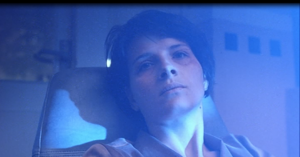
The second time blue light flashes across Julie’s face, the lights appear to be small reflections off something – but the source is again unclear – possibly a ring. She is thinking about the past and a tear does appear. Is the blue light small because at this point she is acknowledging the past and it is making her sad?
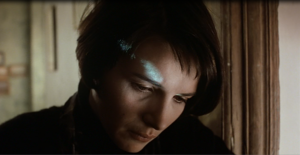
In the third scene where blue lights up Julie’s face, the source is clearly reflections from the swimming pool. She has been playing her husband’s music and clearly is thinking about something sad, presumably her husband. You can see her consciously trying to blank out her thoughts.
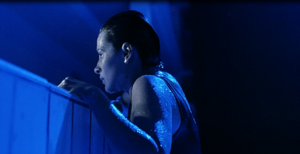
There are many other instances where blue is used to convey meaning. When Julie goes to clear out the house, we see Olivier, the husband’s music partner, carrying a blue folder. It contains the past also – details of Julie’s husband, his music but also pictures of the husband’s lover.
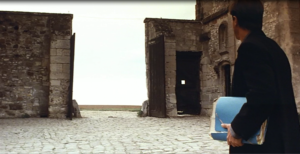
When the lawyer asks Julie if she will explain why she is selling all her possessions – Julie answers ‘no’. However the answer is in her hand which the camera tilts down to and she opens her hand and is shown holding some of the blue parts of a wind chime. This wind chime is associated with her daughter and the blue pieces represent her past and her desire to be free of it – her reason for getting rid of the possessions is to free herself of that past.
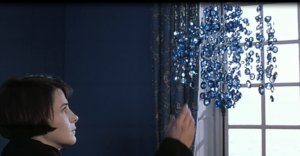
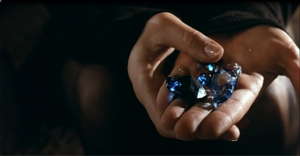
In a later scene, Julie empties out her handbag – the scene is shaded blue and yet again the source is unclear. She finds a lolly in a blue wrapper and she remembers that this is the type of lolly her daughter had when they were in the car. During the opening sequence, Anna is seen releasing the wrapper out the window of the car. Julie unwraps the lolly and puts in in her mouth. At first it appears she will eat it slowly but then she starts crunching on it and consuming it very quickly – as if she is trying to get rid of it as quickly as possible.
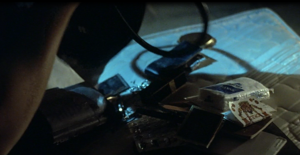
When Julie invites Olivier around to the house with the intention of making love to him – to rid him of his infatuation with her. Whilst undressing and kissing, she is bathed in a blue green light which partially comes from the lights, windows and rain but it is hard to be sure. However, Olivier does not have any of this light on his face or body, even when their faces come close together to kiss – which is rather odd. Yet again, the blue light of the past is on Julie but not on Olivier as he is not dealing with the same grief as she is.
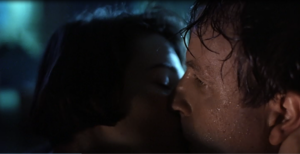
There is a clear reference to the past in the colour blue whilst Julie is sitting on the stairs in the apartment block where she lives. She is falling asleep and as she does so, her husband’s music can be heard, and then flickers of blue light reflect on the screen – the source is definitely not motivated in understandable way. As she wakes, the blue light and her thoughts of past, disappear.
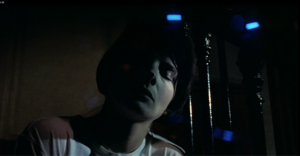
The is one interesting scene in the movie where Julie is sitting in the sunlight and there is non-diegetic flute music playing in the background. There is no blue on her face and she appears to be at peace. The question comes to mind – has she found a way to deal wither grief.
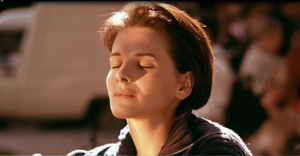
There is a break with the blue colour about half way through the movie. The boy who was first to arrive at the crash site that killed Julie’s family, also picked up a necklace and now was returning it to her. Whilst they speak, he says he was the first to arrive at the site and did she want to know anything about what he found. The scene fades to black for a few seconds with music playing. When the scene fades in again, Julie replies that she doesn’t have any questions. There are a few instances in the movie of this strange fade-out/fade-in technique that symbolises points where Julie has an opportunity to confront her past.
Towards the end of the movie, as Julie starts to embrace the past and live her life again – there is a scene where she and Olivier are speaking on the phone. Julie is now wearing a blue blouse and jersey but the light is normal except for one reflection of green on her hair – indicating that she is growing comfortable ‘wearing her past’ and the green light in her hair may be an indicator of her coming to terms with her grief.
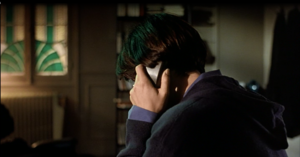
Three Colours: Blue [feature film, DVD]. Dir. Krzysztof Kieslowski. MK2 Productions, CED Productions, France 3 Cinema. France, Poland, Switzerland, 1993. 98 min.
